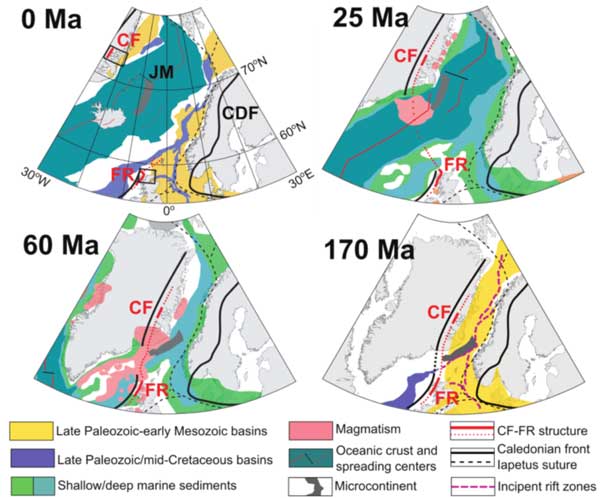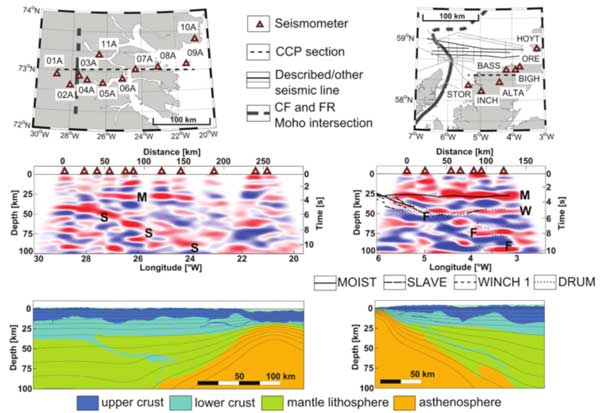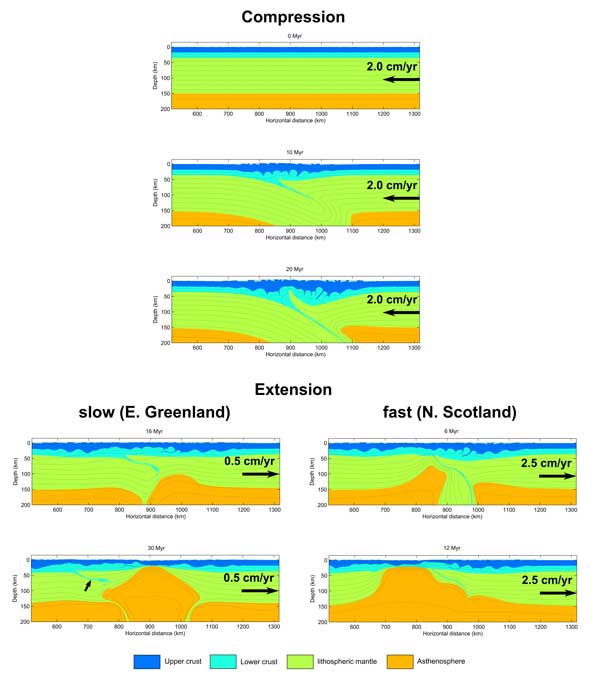 |
A sub-crustal piercing point for North Atlantic reconstructions and tectonic implications |
Christian Schiffer1, Randell A. Stephenson1,2, Kenni D. Petersen1, Søren B. Nielsen1, Bo H. Jacobsen1, Niels Balling1 & David I.M. Macdonald2
1Department of Geoscience, Aarhus University, Høegh-Guldbergs Gade 2, DK-8000 Aarhus C., Denmark; christian.schiffer@geo.au.dk ; kenni@geo.au.dk ; sbn@geo.au.dk ; bo@geo.au.dk ; niels.balling@geo.au.dk
2School of Geosciences, University of Aberdeen, King’s College, Aberdeen AB24 3UE, UK; r.stephenson@abdn.ac.uk ; d.macdonald@abdn.ac.uk
This webpage is a summary of: Schiffer, C., Stephenson, R.A., Petersen, K.D., Nielsen, S.B., Jacobsen, B.H., Balling, N., and Macdonald, D.I.M., 2015, A sub-crustal piercing point for North Atlantic reconstructions and tectonic implications: Geology, 43, no. 12, p. 1087–1090, doi: 10.1130/G37245.1
Introduction
Fitting conjugate continental margins together is dependent on many, often complicated, interpretations and assumptions about the crust and lithosphere of conjugate rifted continental margins. This includes, for example, their structure, thickness and affinity (oceanic or continental), the identification of rifted continental slivers and areas of exhumed upper mantle, and accordingly the choice of the ocean-continent transition (Skogseid et al., 2000; Lundin & Doré, 2011; Gernigon et al., 2015). In our recent paper (Schiffer et al., 2015) we proposed a novel method of making plate-tectonic reconstructions in the North Atlantic by correlation of upper-mantle structures imaged by seismological techniques in East Greenland and Scotland. We also discuss the implications for the extensional and magmatic evolution in the region.

Figure 1. Present day North Atlantic and palaeogeographic reconstructions at 25 Ma, 60 Ma and 170 Ma (after Skogseid et al., 2000; Torsvik et al., 2002). CF – Central Fjord system array; FR – Flannan reflector; JM – Jan Mayen; CDF – Caledonian Deformation Front. Black boxes at 0 Ma outline the study areas around the CF array and the FR. Red lines are where these structures intersect the Moho (Chadwick & Pharaoh, 1998; Schiffer et al., 2014); stippling indicates where less constrained or inferred.
Correlation of two upper mantle structures in the North Atlantic
The Flannan Reflector (FR) is a large, east-dipping structure in the upper mantle offshore northwest Scotland and was discovered by deep seismic profiling in the 1980s (Smythe et al., 1982). A similar structure was recently discovered on the other side of the North Atlantic, using receiver function imaging with broadband data from the Central Fjord (CF) region in East Greenland (Schiffer et al., 2014). We have re-analysed Scottish data using the same techniques as used for Greenland and show that the FR and the CF structure are seismologically similar and both likely relicts of a subduction zone complex. In plate tectonic reconstructions these structures align along Caledonian lineaments, such as the Caledonian deformation front (Figure 1), and therefore we concluded that they are one and the same, broken apart and separated when the North Atlantic Ocean formed some 50 million years ago.

Figure 2. Comparison of results in the cases of E. Greenland at ~73°N (left) and N. Scotland at ~58°N (right). Note that these are not conjugate margin pairs. Upper panel: Location of seismic stations. Thick dark grey line – Moho intersection of the CF structure and the FR (Chadwick & Pharaoh, 1998). Black and grey lines – deep seismic reflection lines (Flack & Warner, 1990). Middle panel: Receiver function images of the CF array and of seven Scottish stations. Red and blue indicate positive and negative conversions, respectively. Superimposed black lines are sub-Moho reflections from seismic lines. M – Moho. S – CF structure. F – Flannan reflector. W – W-reflector. Lower panel: Structural images of the numerical modelling.
Numerical modelling
By means of 2D geodynamic modelling of a representative tectonic scenario for the North Atlantic using a multigrid-based (Petersen et al., 2015) marker-in-cell method (Gerya & Burg, 2007), we demonstrated that subducted crustal material can survive the process of orogenic collapse and continental breakup of an initially sutured orogenic belt (Figure 3). The models represent a generic example of a phase of continent-continent collision followed by subsequent either fast (2.5 cm/yr) or slow (0.5 cm/yr) extension. While in a fast extension scenario subducted crust is preserved in the upper mantle east of the break-up (Scotland), slow extension produces a crustal remnant in the west of the break-up (Greenland), in agreement with rifting rates in the North Atlantic (1-2 cm/yr at the Reykjanes Ridge; 0.5-1.5 cm/yr at the Mohns Ridge; Mosar et al., 2002).

Figure 3. Numerical modelling results. Dark blue – upper continental crust. Light blue – lower continental crust. Green – mantle lithosphere. Orange – asthenosphere. Upper panel: continent-continent convergence over a period of 20 Myr and a convergence rate of 2 cm/yr. Lower continental crust is entrained in the lithospheric mantle. Lower panel: Left - slow extension (0.5 cm/yr) of the modelled orogen – a template for the CF structure. Right – fast extension (2.5 cm/yr) of the modelled orogen – a template for the FR structure. In both cases, the underthrusted lower continental crustal sliver (marked by the black floating arrows) is preserved, even after rifting. Click here or on Figure to enlarge.
Tectonic control on North Atlantic geodynamic evolution
Seismological analysis, plate tectonic reconstructions and numerical modelling support the interpretation that the upper mantle structures in East Greenland and northern Scotland are the remnants of the same fossil subduction zone of pre- to early-Caledonian age. This inferred sub-Moho structure may have imposed a fundamental control on major tectonic events during opening of the North Atlantic. Post-Caledonian extension is dominantly observed east of the CF-FR structure (Figure 1, 170 Ma). Later, global extrinsic tectonic forces, propagating from south to north (Nielsen et al., 2007) induced continental break-up. The extreme magmatic outburst associated with the later build-up of present-day Iceland occurred where this rift system crossed the CF-FR structure, with the initial stages of magmatism predominantly affecting the region west of the CF-FR structure (Figure 1, 60 Ma). By 25 Ma (Figure 1) seafloor spreading at the Ægir Ridge discontinued and was transferred to the Kolbeinsey Ridge (Gernigon et al., 2015). This rift axis west of the Jan Mayen microcontinent coincides with location and strike of the CF-FR structure and we speculate that this might be related to the formation of the so-called “Iceland Insular Margin” (Doré et al., 2008).
We think that the observed CF-FR sub-Moho structure represents inherited crustal material that might have enhanced melting (Foulger et al., 2005), alongside other possible processes, such as higher temperature and compositional variation (Brown & Lesher, 2014) or water (Jamtveit et al., 2001) in the upper mantle.
Aligning these upper mantle structures creates a close-fit reconstruction with the effect of removing extension from the Rockall Trough (Figure 1, 170Ma) that is otherwise difficult to reconcile. This is the first time a sub-crustal “piercing point” has ever been proposed for reconstructing past positions of the Earth’s tectonic plates and has implications for how the adjacent, conjugate margins of the North Atlantic fit together before they broke apart.
References
-
Brown, E.L., and Lesher, C.E., 2014, North Atlantic magmatism controlled by temperature, mantle composition and buoyancy: Nature Geoscience, 7, 820–824, doi: 10.1038/ngeo2264.
-
Chadwick, R.A., and Pharaoh, T.C., 1998, The seismic reflection Moho beneath the United Kingdom and adjacent areas: Tectonophysics, 299, 255–279, doi: 10.1016/S0040-1951(98)00193-0.
-
Flack, C., and Warner, M., 1990, Three-dimensional mapping of seismic reflections from the crust and upper mantle, northwest of Scotland: Tectonophysics, 173, 469–481, doi: 10.1016/0040-1951(90)90239-5.
-
Foulger, G.R., Natland, J.H., and Anderson, D.L., 2005, A source for Icelandic magmas in remelted Iapetus crust: Journal of Volcanology and Geothermal Research, 141, 23–44, doi: 10.1016/j.jvolgeores.2004.10.006.
-
Gernigon, L., Blischke, A., Nasuti, A., and Sand, M., 2015, Conjugate volcanic rifted margins, sea-floor spreading and microcontinent: Insights from new high-resolution aeromagnetic surveys in the Norway Basin: Tectonics, doi: 10.1002/2014TC003717.
-
Gerya, T.V., and Burg, J.-P., 2007, Intrusion of ultramafic magmatic bodies into the continental crust: Numerical simulation: Physics of the Earth and Planetary Interiors, 160, 124–142, doi: 10.1016/j.pepi.2006.10.004.
-
Jamtveit, B., Brooker, R., Brooks, K., Larsen, L.M., and Pedersen, T., 2001, The water content of olivines from the North Atlantic Volcanic Province: Earth and Planetary Science Letters, 186, 401–415, doi: 10.1016/S0012-821X(01)00256-4.
-
Lundin, E.R., and Doré, A.G., 2011, Hyperextension, serpentinization, and weakening: A new paradigm for rifted margin compressional deformation: Geology, 39, 347–350, doi: 10.1130/G31499.1.
-
Mosar, J., Torsvik, T.H., and BAT team, 2002, Opening of the Norwegian and Greenland Seas: Plate tectonics in mid Norway since the Late Permian, in BATLAS – Mid Norway plate reconstructions atlas with global and Atlantic perspectives, Geological Survey of Norway, p. 48–59.
-
Nielsen, S.B., Stephenson, R., and Thomsen, E., 2007, Dynamics of Mid-Palaeocene North Atlantic rifting linked with European intra-plate deformations: Nature, 450, 1071–1074, doi: 10.1038/nature06379.
-
Petersen, K.D., Armitage, J.J., Nielsen, S.B., and Thybo, H., 2015, Mantle temperature as a control on the time scale of thermal evolution of extensional basins: Earth and Planetary Science Letters, 409, 61–70, doi: 10.1016/j.epsl.2014.10.043.
-
Schiffer, C., Balling, N., Jacobsen, B.H., Stephenson, R.A., and Nielsen, S.B., 2014, Seismological evidence for a fossil subduction zone in the East Greenland Caledonides: Geology, 42, 311–314, doi: 10.1130/G35244.1.
-
Schiffer, C., Stephenson, R.A., Petersen, K.D., Nielsen, S.B., Jacobsen, B.H., Balling, N., and Macdonald, D.I.M., 2015, A sub-crustal piercing point for North Atlantic reconstructions and tectonic implications: Geology, 43, 1087–1090, doi: 10.1130/G37245.1.
-
Skogseid, J., Planke, S., Faleide, J.I., Pedersen, T., Eldholm, O., and Neverdal, F., 2000, NE Atlantic continental rifting and volcanic margin formation: Geological Society, London, Special Publications, 167, 295–326, doi: 10.1144/GSL.SP.2000.167.01.12.
-
Smythe, D.K., Dobinson, A., McQuillin, R., Brewer, J.A., Matthews, D.H., Blundell, D.J., and Kelk, B., 1982, Deep structure of the Scottish Caledonides revealed by the MOIST reflection profile: Nature, 299, 338–340, doi: 10.1038/299338a0.
-
Torsvik, T.H., Carlos, D., Mosar, J., Cocks, L.R.M., and Malme, T., 2002, Global reconstructions and North Atlantic palaeogeography 400 Ma to Recent., in BATLAS – Mid Norway plate reconstructions atlas with global and Atlantic perspectives, Geological Survey of Norway, p. 18–39.
last updated 12th
January, 2016 |
